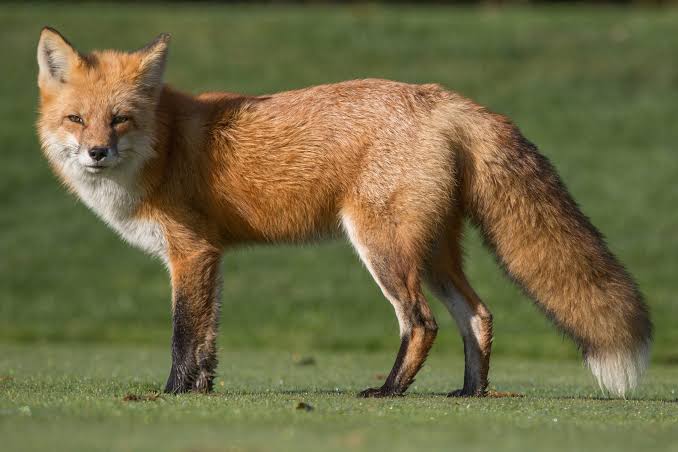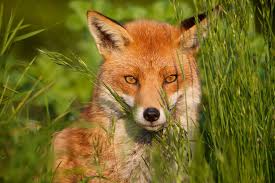Foxes, scientifically known as Vulpes, are fascinating creatures that belong to the Canidae family. These small to medium-sized mammals are known for their distinctive pointed snouts, bushy tails, and keen intelligence. Foxes are found in diverse habitats, including forests, grasslands, deserts, and urban areas, showcasing their adaptability.
These clever animals are renowned for their resourcefulness in hunting and scavenging. Foxes primarily feed on small mammals, birds, insects, and fruits. Their diet can vary based on their environment and seasonal availability of food. Foxes are known for their ability to pounce and catch prey with remarkable agility.
One notable feature of foxes is their beautiful fur, which varies in color among different species. The red fox, for instance, has a striking reddish-brown coat, while other species may exhibit gray, silver, or black fur. The fur not only provides insulation against harsh weather but also aids in camouflage during hunting.
Foxes are known for their playful behavior, particularly among young cubs. They engage in games that help develop their hunting and social skills. Foxes are also skilled diggers, creating underground burrows called dens. These dens serve as shelter and a safe space for raising their young, known as kits or cubs.
The social structure of foxes is diverse, with some species being solitary while others exhibit more communal living. Red foxes, for example, are often solitary, while Arctic foxes may form small family groups. Foxes communicate using a variety of vocalizations, including barks, screams, and howls, to convey different messages to each other.
Foxes have made their mark in folklore and mythology across various cultures. Often portrayed as cunning and sly, foxes are characters in fables and stories that highlight their cleverness. Despite their reputation, foxes play a vital role in ecosystems by controlling populations of small rodents and insects.
In recent times, human expansion into fox habitats has led to increased interactions between foxes and urban environments. Foxes have adapted to urban life, scavenging for food in human settlements. However, this adaptation has also led to conflicts with humans, as some view foxes as pests.
Conservation efforts are crucial to maintaining healthy fox populations. Habitat preservation, awareness programs, and responsible waste management can contribute to coexistence between humans and foxes. Understanding and appreciating these intelligent creatures can foster a harmonious balance in the ecosystems they inhabit.
Read Also: Importance of Amino Acids in Poultry Nutrition
Plants and Animals Affected by Foxes (Vulpes)

Foxes can have both direct and indirect effects on the plants and animals within their ecosystems. While they play a crucial role in controlling certain species’ populations, their predation and behavior can impact others.
1. Prey Species:
Small Mammals: Foxes primarily prey on small mammals like rabbits, rodents, and birds. This can influence the population dynamics of these species in a given area.
Ground-Nesting Birds: Foxes are known to raid the nests of ground-nesting birds, affecting bird populations in local ecosystems.
2. Impact on Insects: Insects play a role in the diet of some fox species. While the impact on insect populations might be less noticeable compared to larger prey, it can still contribute to the complex web of interactions in the ecosystem.
3. Vegetation and Plants: Indirectly, foxes can influence vegetation and plant life. By controlling herbivore populations, foxes indirectly affect the vegetation that herbivores feed on. This can have cascading effects on the entire ecosystem.
4. Interactions with Other Predators: Foxes may compete with other predators for resources. For example, they might compete with larger carnivores like coyotes or domestic dogs, influencing the distribution and abundance of these species.
5. Impact on Endangered Species: In some regions, particularly where foxes have been introduced, they can pose a threat to native and endangered species. The absence of natural predators in these ecosystems can result in foxes preying on vulnerable species, impacting their survival.
6. Human Interactions: Foxes adapting to urban environments can have consequences for domestic pets, such as small cats and backyard poultry. This can lead to conflicts between foxes and humans.
7. Seed Dispersal: Foxes might inadvertently contribute to seed dispersal by carrying seeds in their fur or digestive systems. This can play a role in the distribution of plant species within their habitats.
Understanding the ecological relationships involving foxes is essential for effective conservation management. While they help regulate certain species, their presence can also pose challenges in specific contexts. Conservation efforts often involve a balanced approach to maintain biodiversity and mitigate negative impacts on vulnerable species.
Damages Caused by Foxes

Foxes can cause various damages, especially in human-impacted environments. While they play a crucial role in ecosystems, their interactions with human activities can lead to specific challenges and damages.
1. Livestock and Poultry Predation: Foxes, particularly in rural areas, may prey on livestock such as chickens, ducks, and rabbits. This can lead to economic losses for farmers and backyard animal keepers.
2. Garden and Crop Damage: Urban and suburban foxes may cause damage to gardens and crops. They may dig in lawns or flower beds, and their scavenging behavior can impact fruits and vegetables.
3. Transmission of Diseases: Foxes can be carriers of diseases such as rabies and mange. While transmission to humans is rare, there’s a risk of diseases being transmitted to domestic pets, posing a health concern.
4. Impact on Native Wildlife: In regions where foxes are introduced or not native, they can pose a threat to native wildlife. Their predation can lead to declines in populations of small mammals, birds, and ground-nesting species.
5. Nuisance Behavior: Foxes adapting to urban environments may exhibit nuisance behaviors. This can include digging in trash bins, creating dens in residential areas, and making loud vocalizations, leading to conflicts with humans.
6. Interactions with Domestic Pets: Foxes can pose a threat to small domestic pets, such as cats and small dogs. Interactions with domestic animals may result in injuries or conflicts.
7. Disturbance to Ecosystems: In areas where foxes are not native, their presence can disturb ecosystems by preying on species that are not adapted to such predation. This can lead to imbalances and negatively impact biodiversity.
8. Impact on Ground-Nesting Birds: Foxes are known for raiding nests, especially ground-nesting bird nests. This can lead to declines in bird populations and affect the overall diversity of avian species in an area.
9. Roadkill: Foxes, like many other wildlife species, are susceptible to being hit by vehicles on roads. This not only poses a risk to fox populations but also raises safety concerns for drivers.
Balancing conservation efforts with addressing the damages caused by foxes requires a comprehensive approach. Implementing strategies such as secure livestock enclosures, responsible waste management, and public education can help minimize conflicts between foxes and human activities.
Read Also: Fowl Cholera Disease and Methods of Treatment
Control and Preventive Measures

Implementing control and preventive measures is essential to manage potential conflicts between foxes and human activities. Here are several strategies that can be employed:
1. Secure Livestock Enclosures: Use sturdy fencing to secure livestock areas, such as chicken coops and rabbit hutches, to prevent foxes from gaining access to domestic animals.
2. Electric Fencing: Electric fencing can be an effective deterrent for foxes. Installing it around vulnerable areas can discourage their entry.
3. Secure Waste Management: Properly secure trash bins and avoid leaving pet food outdoors to reduce scavenging opportunities for foxes in urban and suburban areas.
4. Use Motion-Activated Lights or Alarms: Install motion-activated lights or alarms in areas where foxes may frequent. This can startle them and discourage them from approaching.
5. Habitat Modification: Make changes to the environment to make it less attractive to foxes. This can include removing dense vegetation or debris that might serve as shelter.
6. Repellents: Various commercial and homemade repellents are available that can deter foxes. These can be applied to specific areas or objects to discourage their presence.
7. Trapping and Relocation: In some cases, trapping and relocating foxes may be considered. However, this approach requires careful consideration of local regulations and should be done by trained professionals.
8. Responsible Pet Management: Keep small pets, such as cats and small dogs, indoors or supervise them when outside, especially during dawn and dusk when foxes are more active.
9. Public Education: Educate the public about coexisting with wildlife, emphasizing the importance of not feeding foxes and understanding their natural behaviors.
10. Vaccination Programs: Implementing vaccination programs for domestic pets in regions where foxes are carriers of diseases can help prevent the spread of diseases like rabies.
11. Habitat Preservation: Protect and preserve natural habitats to maintain a healthy balance in ecosystems, allowing foxes to fulfill their ecological roles without causing excessive disturbances.
12. Monitoring and Research: Regular monitoring of fox populations and their behaviors can provide valuable insights. Research efforts can contribute to a better understanding of their ecological impact and aid in developing effective management strategies.
Effective fox management involves a combination of these measures, tailored to specific contexts and environments. Striking a balance between conservation and addressing conflicts with human activities is crucial for promoting harmonious coexistence.
Frequently Asked Questions (FAQs) About Foxes (Vulpes)
1. Q: What do foxes eat?
A: Foxes have a varied diet, including small mammals, birds, insects, fruits, and scavenged food. Their diet can vary based on the species and the environment they inhabit.
2. Q: Are foxes dangerous to humans?
A: Generally, foxes are not considered dangerous to humans. They are shy and tend to avoid human interactions. However, in urban areas, they may become more accustomed to people, and caution is advised, especially with pets.
3. Q: Do foxes live in groups or alone?
A: Foxes display diverse social structures. Some species, like the red fox, are often solitary, while others, like the Arctic fox, may form small family groups. The social structure depends on the species and environmental factors.
4. Q: What is a fox’s lifespan in the wild?
A: The lifespan of a fox in the wild varies by species. On average, it ranges from 3 to 4 years, although some species may live longer.
5. Q: Do foxes hibernate?
A: No, foxes do not hibernate. They remain active year-round, adapting to seasonal changes in their environment.
6. Q: Can foxes be kept as pets?
A: In many places, keeping a fox as a pet may be illegal or require special permits. Additionally, foxes have specific needs and behaviors that may make them challenging as domesticated animals.
7. Q: Are foxes nocturnal?
A: Foxes are crepuscular, meaning they are most active during dawn and dusk. However, in urban areas, they may adjust their activity patterns and be more active at night.
8. Q: Do foxes make good pest control?
A: Yes, foxes play a role in controlling populations of small mammals and insects. They contribute to the balance of ecosystems by helping regulate certain species.
9. Q: How can I deter foxes from my property?
A: Securing trash bins, using fencing, and employing repellents are common methods to deter foxes. Additionally, removing potential food sources and modifying the environment can make an area less attractive to them.
10. Q: What diseases do foxes carry?
A: Foxes can carry diseases such as rabies and mange. While transmission to humans is rare, domestic pets may be at risk. Vaccination programs for pets can help prevent the spread of diseases.
Read Also: E-Business Opportunities for Expansion

